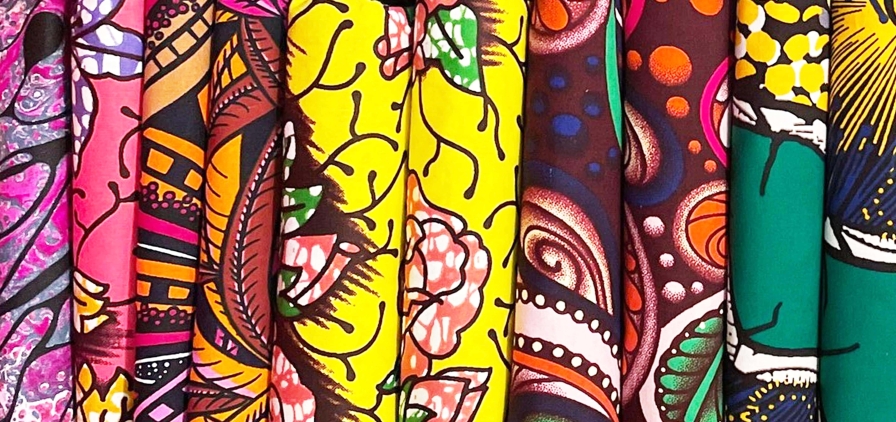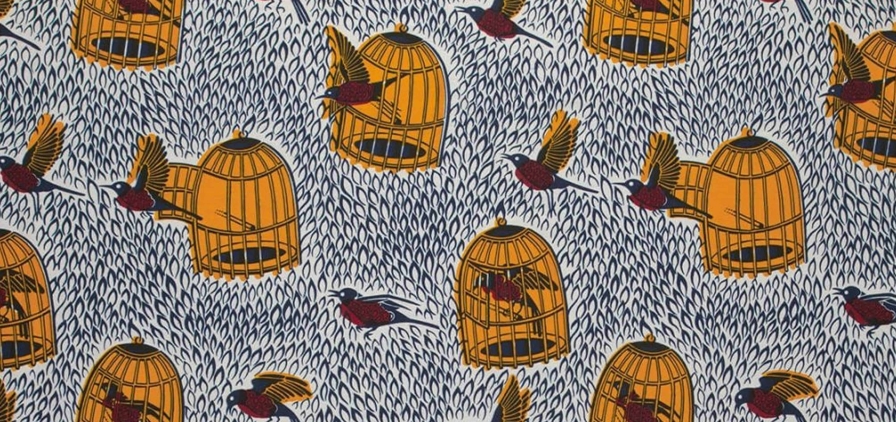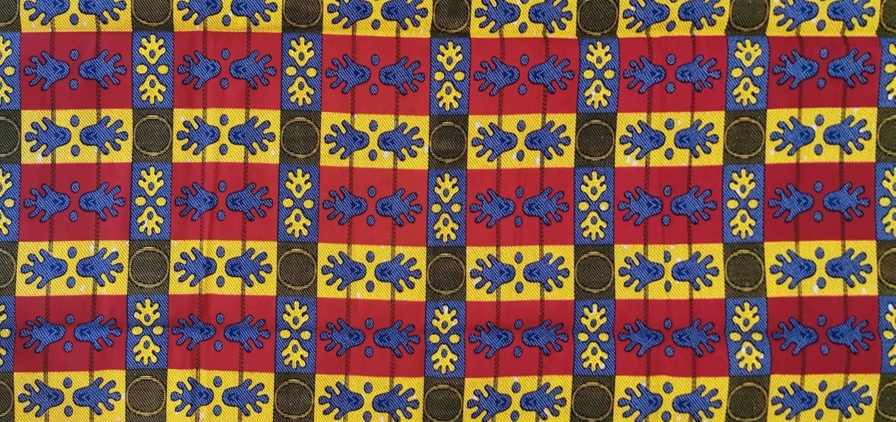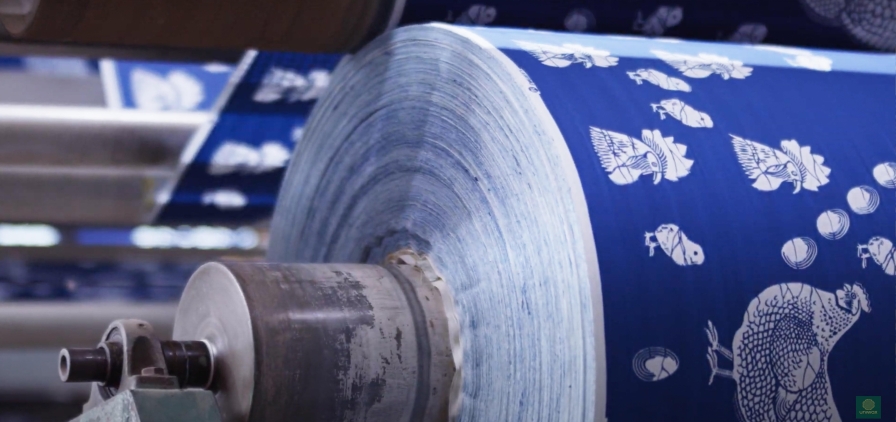
The African surface pattern, between tradition and meaning
A bit like a griot under the palaver tree, African wax always tells an adventure, a story, the latter truly being part of the history of textile patterns. Its vibrant ethnic patterns, full of popular wisdom or fantasy, have made it the most famous fabric in Africa. Haute couture itself turns its attention to this massively appreciated and worn African specialty, which works wonders in a textile collection and inspires numerous creations on paper and digitally. Let's explore the world of wax, discovering its origin and its symbolic aspects.
What is African wax fabric?
Wax, definition
Wax is a cotton canvas decorated with colorful surface patterns in vibrant colors. Its manufacturing technique combines dyeing and printing. It is primarily based on the application of wax or resin to the fabric to create reserve areas. One of the particularities of African wax fabric is that it has neither right side nor reverse. Wax is distinguished by its tribal and abstract patterns that evoke African art and modern aspirations.
Creating the design of a traditional wax requires around twenty operations, as well as several washing and drying phases. Once produced, wax fabric is most often marketed in the form of African loincloth. These large rectangles of fabric can be used as is, draped and tied, or used to make different types of clothing: dresses, skirts, pants, shirts, hats, bags and accessories. These fabrics lend themselves to both decoration and fashion, with applications for curtains, illustrations and other interior decorations.
Origins
Wax is considered the most emblematic fabric of the African continent, but in reality, its process originates from Asia, more precisely from the island of Java. What makes wax unique are the surface patterns which, although of Javanese origin, have been adapted to meet African tastes and desires.
In the 19th century, seduced by the beauty of Javanese batiks and attracted by their commercial prospects, English and Dutch settlers decided to appropriate this technique. After having developed machines in Europe to print batiks industrially, they launched into the Indonesian market with their own productions. Wasted effort, these printed fabrics did not meet with the expected success in Asia. It was ultimately by traveling to the west coast of Africa (Ghana) that European batiks found their audience.
Initially reserved for the elite because they were expensive, Indonesian-inspired Dutch batiks were quickly revisited to adapt to African cultural traditions. The designs are evolving, the craze is spreading to the regions of West Africa, to Central Africa and rural areas. The African wax industry is growing in Africa, even if Dutch wax remains historically prized for its premium quality. This textile specialty now shines internationally under the generic name wax, the name it bears in West Africa. Elsewhere on the African continent it is sometimes called Ankara. In East Africa, it is called Kitenge or Chitenge and is available on slightly lighter cotton fabrics.
When surface pattern is a language
Traditionally, African wax has symbolic value. Its surface patterns constitute an implicit language mastered by those who wear it. Thanks to it, clothing becomes both a marker of identity within a community and a messenger. Each design says a lot about the person who wears it and as much about the person who contemplates it. Ultimately, African loincloths constitute a form of silent speech. Used as a social mirror, they transmit a clear message that everyone can understand, making each textile pattern both personal and universal.
The name of a design and its meaning may vary slightly depending on regional cultural habits, but the designations are chosen to “speak to everyone”. Having a name is also a consecration for a reason, the recognition of one’s success. The wax can tell a story, commemorate an event or simply reflect the state of mind of the person wearing it: jealousy, provocation, rivalry, anger, joy, mourning... Faced with a given situation, everyone can express their feelings without uttering a word. Family life, sentimental or economic, politics, current affairs and major events, wax evokes many social themes. And sets no limits to the inspiration to approach them: figurative or abstract, the graphics can represent geometric or ethnic symbols as well as animals, plants, everyday objects or political figures, all generally worn by a bright color palette rather than black and white! Each pattern is an illustration of the richness of African culture and a tribute to tribal art.

What are the meanings of the African wax surface patterns on the loincloths?
Hibiscus flower
This auspicious floral textile pattern traditionally adorns African loincloths offered to newlyweds. For lovebirds, it is a guarantee of happiness, but also sometimes of wealth and success. This surface pattern is often chosen for its red color which symbolizes love and passion.
Disc, target or well
Record, record player, target, gramophone, well, royal headdress... this very popular African textile pattern inspired by tye and die has several names and it has two meanings. Some interpret the latter as a tribute to music because of its resemblance to a 45 rpm or 33 rpm vinyl. For others, these concentric circles made up of tiny dots represent the waves that form on the surface of water in a well after throwing a pebble into it. Seen from this angle, this model symbolically reminds us that each of our actions and decisions has repercussions on those around us. The white background on which these surface patterns are applied accentuates the clean and symbolic aspect of the design.
“If you steal, I steal”
Also called “If you go out, I go out too”, this African pattern illustrating a bird flying from its open cage has a double meaning. In the best case scenario, it represents the flight of newlyweds who spread their wings in their new life together. In other circumstances, it can also be interpreted as a wife's warning to a fickle husband. This surface pattern is often made in black and white, to emphasize the contrast of the emotions it evokes.

Swallows
In Africa, swallows symbolize money, freedom and happiness. The swallow, also called “Bird in flight”, is therefore a sign of good omen. But be careful of the other side of the coin, particularly in Ghana, where this reason calls for caution and above all economy. Because just like this swallow, money tends to slip through the fingers of those who do not manage their budget reasonably! The shades used for this animal pattern are often soft, with a sky blue or pale green background, evoking tranquility and serenity.
Shellfish
Compared to a helmet or a bunch of bananas depending on the region, this traditional pattern revisits an ancient Hindu graphic theme called “The wings of Garuda”. This great classic has several meanings, but in Togo, it is an invitation to mind your own business! This surface pattern in white and red on a black background is particularly popular for curtains and other interior decoration elements.
“Honey, don’t turn your back on me”
Hypnotic, this geometric surface pattern represents interlocking shapes in rosettes. The message it carries is less cheerful than its colors, which are most often bright. Indeed, women use it to express their concern about being abandoned for another by a husband who has become too indifferent. This African pattern is often reproduced in illustrations on paper, where it retains all its symbolic force.
Sugar cane
This vegetal textile pattern goes well beyond paying homage to a culture that sustains part of the African continent; this surface pattern, which sometimes resembles bamboo stems, indicates that its wearer is as sweet as cane sugar. In a couple, we also use it to declare or renew our love for the person we love. The sweet tones of this pattern make it a particularly popular choice for ethnic-style clothing and decorations.
Eye
The eye is a recurring pattern on African loincloths. This design can be worn by a woman to show her desire to the man she covets. It comes in different forms: the bull's eye, my rival's eye, even the vindictive "I'm spraying my rival's eye" which needs no explanation. These black and red African designs on a white background are often associated with strong feelings and are widely used in premium couture collections.
Cowries
The cowrie is a small shell of importance in African traditions. It has long been used as currency and is still considered a good luck charm. This surface pattern is often chosen for its images of wealth and prosperity.
Fan
In the 80s, this African surface pattern was associated with modernity and comfort. By extension, there remains a way of showing that we enjoy a good lifestyle, even a certain opulence. Like other representations of common objects such as the watch, the wallet, English shoes, car candles or the supermarket trolley, it is often interpreted as an external sign of wealth, proven or hoped for. This textile object pattern nevertheless gradually lost its initial meaning, fulfilling more of a stylistic mission rather than an illustration role full of symbols.
Leopard, snake
This design is intended to represent the skin of a panther, snake, or small pebbles. Alone, it means that harm inflicted by a loved one or family member is always more painful than when initiated by a stranger. When it is punctuated with purses, it symbolizes the wealth to which the woman who wears the African loincloth aspires. The colors used in these designs are often inspired by natural hues, with lots of black and red to evoke strength and passion.
Hand
The hand is a recurring graphic theme on wax prints. Filled with coins and surrounded by a row of fingers, it is a sign of good fortune, emphasizing the fact that “unity is strength”. In Togo, it can also mean that a young bride has every interest in not arriving at her wedding empty-handed, at the risk of finding herself financially dependent on her husband. This African surface pattern is often depicted on a bright colored background, to symbolize energy and vitality.
Chickens and eggs / The family
Illustration of the "ideal home", the hen, the rooster's head, the chicks and the eggs animating this African pattern highlight the importance of family values and clearly place the woman at the center of the organization of the family. The surface patterns of this design are often used in illustrations to emphasize the importance of family ties in African ethnic culture.
“The child is better than the money”
Like its name taken from an African saying, the narrative dimension of this African pattern is focused on female fertility with the representation of seeds, fetuses, eggs and chicks. This pattern emphasizes the importance of the child for the future of African society. The shades used are generally soft, with pastel tones, to evoke images of tenderness and innocence.
“Your foot, my foot”
This African pattern often evokes a vision of the couple based on harmony. In love, as in a dance, the steps of one must harmonize with those of the other to go in the same direction and maintain a certain balance! Conversely, it can also indicate that if one of the two spouses exceeds the limits, the other will not delay in doing the same. This design is often chosen with complementary colors, thus reinforcing the harmony and balance of the pattern.

Alphabet
This strong symbol composed of letters, numbers and blackboards was previously proudly displayed by those who had the privilege of being part of the literate people. He retained this symbolism, but computers replaced blackboards. This surface pattern is particularly popular in modern sewing patterns, where it is often used for clothing and home decor.
Jumping horse
These rather particular animal textile patterns have a meaning sometimes called “I run faster than my rival” which varies depending on the country. In Ivory Coast, this prancing horse generally emphasizes female rivalry, while in Nigeria it rather displays the cohesion of a group of women. The surface patterns in this design are often chosen for their ability to express complex feelings and capture the very essence of tribal art.
Scepter, Apollo Rocket or Corkscrew
This very ancient African pattern originally represented a royal command scepter of the Akan tribe, but its meaning took an unexpected detour. Initially reserved for an elite, it evolves over history and current events. After paying homage to the Apollo rocket in the 1960s, it was renamed “corkscrew” because of its resemblance to this mundane object. Other sacred objects emblematic of the Akan tribe, such as the fly swatter or the stool, have also become famous surface patterns in wax cotton textiles.
“My husband is capable”
The garlands of lips drawn on this African wax model represent the love that a husband feels towards his other half, and imply that he has the means to offer her a good life. This design is often used in illustrations to express the strength of feelings in a relationship.
“Sweep your yard”
This model could also have been called “before seeing the speck in your neighbor’s eye, look instead at the beam in yours”. It's difficult to be more explicit than this African pattern which directly invites you to mind your own business. This surface pattern is often chosen for clothing and decorations that seek to express a strong and direct message.

Table of the meaning of african wax textile patterns
|
Textile pattern |
Category |
Main Meaning |
Colors |
|---|---|---|---|
|
Hibiscus Flower |
Floral textile pattern |
Good omen, love, prosperity |
Red |
|
Disk / Well |
Geometric seamless pattern |
Tribute to music / impact of actions |
White background; concentric dots |
|
“If you steal, I steal” |
Animal textile pattern |
Newlyweds taking flight / marital warning |
Black and white |
|
Swallows |
Animal seamless pattern |
Money, freedom, happiness |
Sky blue or pale green (gentleness, serenity) |
|
Seashell |
Geometric textile pattern |
An invitation to mind one’s own business |
White and red on a black background |
|
“Honey, don’t turn your back on me” |
Geometric textile design |
Fear of being abandoned by one’s husband |
Bright colors |
|
Sugarcane |
Vegetal textile pattern |
Sweetness, love |
Sweet tones |
|
Eye |
Abstract seamless pattern / texture |
Desire, rivalry |
Black and red on a white background |
|
Leopard / Snake |
Animal textile pattern |
Family conflicts / wealth |
Black and red, natural tones |
|
“The child is better than the money” |
Abstract seamless pattern / texture |
Fertility, importance of the child |
Pastel tones |
|
"Your Foot, My Foot" |
Abstract textile pattern / texture |
Couple harmony |
Complementary and warm colors |

Ultimately, African wax fabric is much more than just a decorative fabric: through its history, influences, and uses, it embodies a living heritage that spans eras and cultures. From its Asian origins to its appropriation by West Africa, it has evolved. Even today, its textile patterns convey messages, express emotions, and reflect social realities, making the fabric a true visual language shared by all.
Like traditional Chinese textile patterns, which can be adapted to both traditional and contemporary clothing, African wax fabric offers remarkable stylistic freedom. Although it is mainly sold in the form of loincloths, it can easily be transformed into dresses, skirts, shirts, or accessories, just as Chinese seamless patterns can enhance a traditional qipao or modernize a scarf, bag, or blouse. Between heritage, storytelling, and creativity, wax continues to inspire fashion and design, confirming its ability to reinvent itself while preserving the cultural richness it embodies.




















